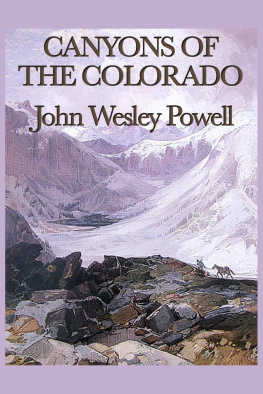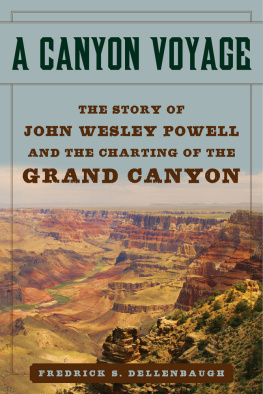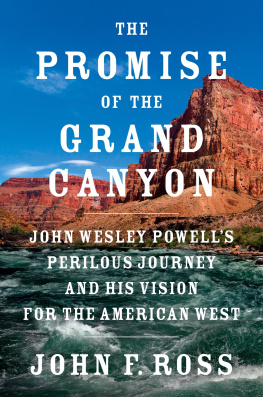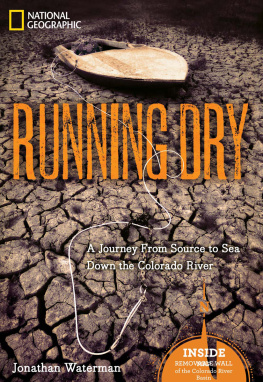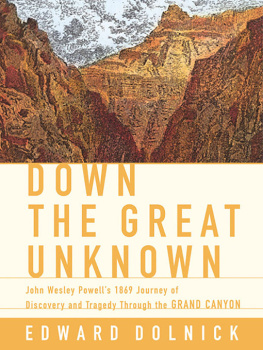John Wesley Powell - Canyons of the Colorado
Here you can read online John Wesley Powell - Canyons of the Colorado full text of the book (entire story) in english for free. Download pdf and epub, get meaning, cover and reviews about this ebook. year: 2013, publisher: Start Publishing LLC, genre: Religion. Description of the work, (preface) as well as reviews are available. Best literature library LitArk.com created for fans of good reading and offers a wide selection of genres:
Romance novel
Science fiction
Adventure
Detective
Science
History
Home and family
Prose
Art
Politics
Computer
Non-fiction
Religion
Business
Children
Humor
Choose a favorite category and find really read worthwhile books. Enjoy immersion in the world of imagination, feel the emotions of the characters or learn something new for yourself, make an fascinating discovery.
- Book:Canyons of the Colorado
- Author:
- Publisher:Start Publishing LLC
- Genre:
- Year:2013
- Rating:4 / 5
- Favourites:Add to favourites
- Your mark:
- 80
- 1
- 2
- 3
- 4
- 5
Canyons of the Colorado: summary, description and annotation
We offer to read an annotation, description, summary or preface (depends on what the author of the book "Canyons of the Colorado" wrote himself). If you haven't found the necessary information about the book — write in the comments, we will try to find it.
John Wesley Powell was a U.S. soldier, geologist, explorer of the American West, and director of major scientific and cultural institutions. He is famous for the 1869 Powell Geographic Expedition, a three-month river trip down the Green and Colorado rivers that included the first passage of European Americans through the Grand Canyon.
Powell served as second director of the US Geological Survey (1881-1894), and was also the director of the Bureau of Ethnology at the Smithsonian Institution, where he supported linguistic and sociological research and publications.
Canyons of the Colorado — read online for free the complete book (whole text) full work
Below is the text of the book, divided by pages. System saving the place of the last page read, allows you to conveniently read the book "Canyons of the Colorado" online for free, without having to search again every time where you left off. Put a bookmark, and you can go to the page where you finished reading at any time.
Font size:
Interval:
Bookmark:

By John Wesley Powell
On my return from the first exploration of the canyons of the Colorado, I found that our journey had been the theme of much newspaper writing. A story of disaster had been circulated, with many particulars of hardship and tragedy, so that it was currently believed throughout the United States that all the members of the party were lost save one. A good friend of mine had gathered a great number of obituary notices, and it was interesting and rather flattering to me to discover the high esteem in which I had been held by the people of the United States. In my supposed death I had attained to a glory which I fear my continued life has not fully vindicated.
The exploration was not made for adventure, but purely for scientific purposes, geographic and geologic, and I had no intention of writing an account of it, but only of recording the scientific results. Immediately on my return I was interviewed a number of times, and these interviews were published in the daily press; and here I supposed all interest in the exploration ended. But in 1874 the editors of Scribners Monthly requested me to publish a popular account of the Colorado exploration in that journal. To this I acceded and prepared four short articles, which were elaborately illustrated from photographs in my possession.
In the same year1874at the instance of Professor Henry of the Smithsonian Institution, I was called before an appropriations committee of the House of Representatives to explain certain estimates made by the Professor for funds to continue scientific work which had been in progress from the date of the original exploration. Mr. Garfield was chairman of the committee, and after listening to my account of the progress of the geographic and geologic work, he asked me why no history of the original exploration of the canyons had been published. I informed him that I had no interest in that work as an adventure, but was interested only in the scientific results, and that these results had in part been published and in part were in course of publication. Thereupon Mr. Garfield, in a pleasant manner, insisted that the history of the exploration should be published by the government, and that I must understand that my scientific work would be continued by additional appropriations only upon my promise that I would publish an account of the exploration. I made the promise, and the task was immediately undertaken.
My daily journal had been kept on long and narrow strips of brown paper, which were gathered into little volumes that were bound in sole leather in camp as they were completed. After some deliberation I decided to publish this journal, with only such emendations and corrections as its hasty writing in camp necessitated. It chanced that the journal was written in the present tense, so that the first account of my trip appeared in that tense. The journal thus published was not a lengthy paper, constituting but a part of a report entitled Exploration of the Colorado River of the West and its Tributaries. Explored in 1869, 1870, 1871, and 1872, under the direction of the Secretary of the Smithsonian Institution. The other papers published with it relate to the geography, geology, and natural history of the country. And here again I supposed all account of the exploration ended. But from that time until the present I have received many letters urging that a popular account of the exploration and a description of that wonderful land should be published by me. This call has been voiced occasionally in the daily press and sometimes in the magazines, until at last I have concluded to publish a fuller account in popular form. In doing this I have revised and enlarged the original journal of exploration, and have added several new chapters descriptive of the region and of the people who inhabit it. Realizing the difficulty of painting in word colors a land so strange, so wonderful, and so vast in its features, in the weakness of my descriptive powers I have sought refuge in graphic illustration, and for this purpose have gathered from the magazines and from various scientific reports an abundance of material. All of this illustrative material originated in my work, but it has already been used elsewhere.
Many years have passed since the exploration, and those who were boys with me in the enterprise areah, most of them are dead, and the living are gray with age. Their bronzed, hardy, brave faces come before me as they appeared in the vigor of life; their lithe but powerful forms seem to move around me; and the memory of the men and their heroic deeds, the men and their generous acts, overwhelms me with a joy that seems almost a grief, for it starts a fountain of tears. I was a maimed man; my right arm was gone; and these brave men, these good men, never forgot it. In every danger my safety was their first care, and in every waking hour some kind service was rendered me, and they transfigured my misfortune into a boon.
To youJ. C. Sumner, William H. Dunn, W. H. Powell, G. Y. Bradley, O. G. Howland, Seneca Howland, Prank Goodman, W. E. Hawkins, and Andrew Hallmy noble and generous companions, dead and alive, I dedicate this book.
Start Publishing LLC
Copyright 2012 by Start Publishing LLC
All rights reserved, including the right to reproduce this book or portions thereof in any form whatsoever.
First Start Publishing eBook edition October 2012
Start Publishing is a registered trademark of Start Publishing LLC
Manufactured in the United States of America
10 9 8 7 6 5 4 3 2 1
ISBN 978-1-62558-351-2
There is a great group of table-lands constituting a geographic unit which have been named the Terrace Plateaus. They ex-tend from the Paria and Colorado on the east to the Grand Wash and Pine Mountains on the west, and they are bounded on the south by the Grand Canyon of the Colorado, and on the north they divide the waters of the Colorado from the waters of the Sevier, which flows northward and then westward until it is lost in the sands of the Great Desert. It is an irregular system of great plateaus with subordinate mesas and buttes separated by lines of cliffs and dissected by canyons.
In this region all of the features which have been described as found in other portions of the province are grouped except only the cliffs of volcanic ashes, the volcanic cones, and the volcanic domes. The volcanic mountains, cinder cones, and coulees, the majestic plateaus and elaborate mesas, the sculptured buttes and canyon gorges, are all found here, but on a more stupendous scale. The volcanic mountains are higher, the cinder cones are larger, the coulees are more extensive and are often sheets of naked, black rock, the plateaus are more lofty, the cliffs are on a grander scale, the canyons are of profounder depth; and the Grand Canyon of the Colorado, the most stupendous gorge known on the globe, with a great river surging through it, bounds it on the south.
The east-and-west cliffs are escarpments of degradation, the north-and-south cliffs are, in the main, though not always, escarpments of displacement. Let us understand what this means. Over the entire region limestones, shales, and sandstones were deposited through long periods of geologic time to the thickness of many thousands of feet; then the country was upheaved and tilted toward the north; but the Colorado River was flowing when the tilting commenced, and the upheaval was very slow, so that the river cleared away the obstruction to its channel as fast as it was presented, and this is the Grand Canyon. The rocks above were carried away by rains and rivers, but not evenly all over the country; nor by washing out valleys and leaving hills, but by carving the country into terraces. The upper and later-formed rocks are found far to the north, their edges standing in cliffs; then still earlier rocks are found rising to the southward, until they terminate in cliffs; and then a third series rises to the southward and ends in cliffs, and finally a fourth series, the oldest rocks, terminating in the Grand Canyon wall, which is a line of cliffs. There are in a general way four great lines of cliffs extending from east to west across the district and presenting their faces, or escarpments, southward. If these cliffs are climbed it is found that each plateau or terrace dips gently to the northward until it meets with another line of cliffs, which must be ascended to reach the summit of another plateau. Place a book before you on a table with its front edge toward you, rest another book on the back of this, place a third on the back of the second, and in like manner a fourth on the third. Now the leaves of the books dip from you and the cut edges stand in tiny escarpments facing you. So the rock-formed leaves of these books of geology have the escarpment edges turned southward, while each book itself dips northward, and the crest of each plateau book is the summit of a line of cliffs. These cliffs of erosion have been described as running from east to west, but they diverge from that course in many ways. First, canyons run from north to south through them, and where these canyons are found deep angles occur; then sharp salients extend from the cliffs on the backs of the lower plateaus. Each great escarpment is made up more or less of minor terraces, or steps; and at the foot of each grand escarpment there is always a great talus, or sloping pile of rocks, and many marvelous buttes stand in front of the cliffs.
Font size:
Interval:
Bookmark:
Similar books «Canyons of the Colorado»
Look at similar books to Canyons of the Colorado. We have selected literature similar in name and meaning in the hope of providing readers with more options to find new, interesting, not yet read works.
Discussion, reviews of the book Canyons of the Colorado and just readers' own opinions. Leave your comments, write what you think about the work, its meaning or the main characters. Specify what exactly you liked and what you didn't like, and why you think so.

